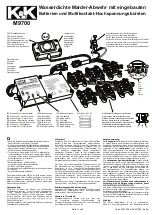
1–2
345 TRANSFORMER PROTECTION SYSTEM – COMMUNICATIONS GUIDE
RS485 INTERFACE
CHAPTER 1: COMMUNICATIONS GUIDE
RS485 interface
The hardware or electrical interface in the 345 is two-wire RS485. In a two-wire link, data is
transmitted and received over the same two wires. Although RS485 two wire
communication is bi-directional, the data is never transmitted and received at the same
time. This means that the data flow is half duplex.
NOTE
NOTE:
Polarity is important in RS485 communications. The '+' (positive) terminals of every device
must be connected together.
Electrical Interface
The hardware or electrical interface in the 345 is two-wire RS485. In a two-wire link, data is
transmitted and received over the same two wires. Although RS485 two wire
communication is bi-directional, the data is never transmitted and received at the same
time. This means that the data flow is half duplex.
RS485 lines should be connected in a daisy chain configuration with terminating networks
installed at each end of the link (i.e. at the master end and at the slave farthest from the
master). The terminating network should consist of a 120 W resistor in series with a 1 nF
ceramic capacitor when used with Belden 9841 RS485 wire. Shielded wire should always
be used to minimize noise. The shield should be connected to all of the 345s as well as the
master, then grounded at one location only. This keeps the ground potential at the same
level for all of the devices on the serial link.
NOTE
NOTE:
Polarity is important in RS485 communications. The '+' (positive) terminals of every device
must be connected together.
MODBUS Protocol
The 345 implements a subset of the Modicon Modbus RTU serial communication standard.
The Modbus protocol is hardware-independent. That is, the physical layer can be any of a
variety of standard hardware configurations. This includes USB, RS485, fibre optics, etc.
Modbus is a single master / multiple slave type of protocol suitable for a multi-drop
configuration.
The 345 is always a Modbus slave. It can not be programmed as a Modbus master.
Computers or PLCs are commonly programmed as masters.
Both monitoring and control are possible using read and write register commands. Other
commands are supported to provide additional functions.
The Modbus protocol has the following characteristics.
•
Address: 1 to 254
•
Supported Modbus function codes: 3, 4, 5, 6, 7, 8, 10
Data Frame Format
and Data Rate
One data frame of an asynchronous transmission to or from a 345 typically consists of 1
start bit, 8 data bits, and 1 stop bit. This produces a 10 bit data frame. This is important for
transmission through modems at high bit rates.
Modbus protocol can be implemented at any standard communication speed. The 345
supports operation at 9600, 19200, 38400, 57600, and 115200 baud.







































